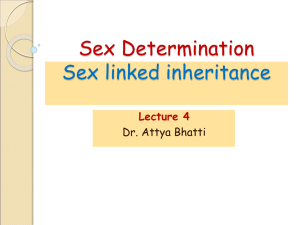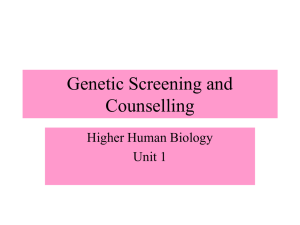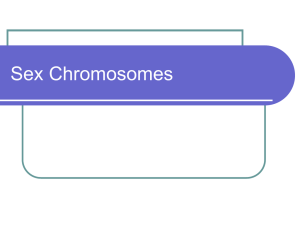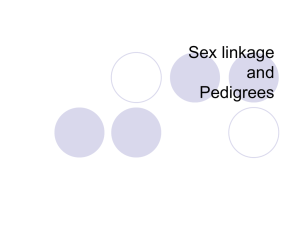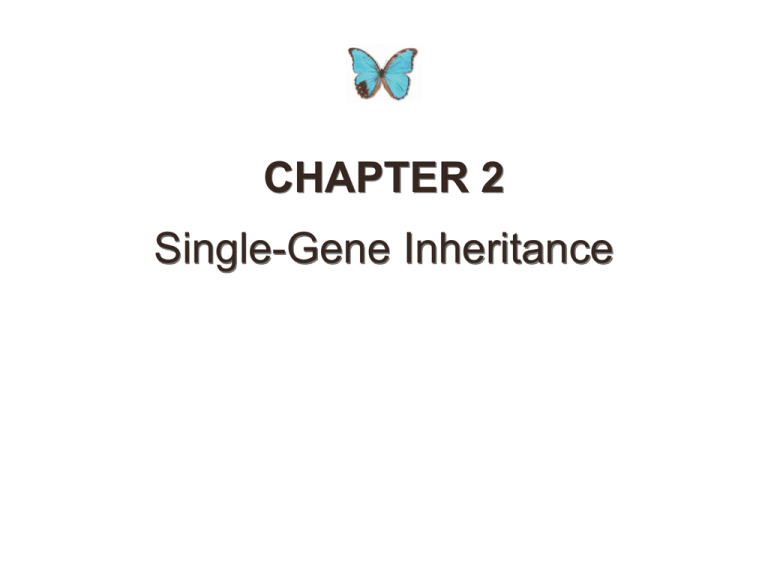
CHAPTER 2
Single-Gene Inheritance
CHAPTER OUTLINE
2.2
2.3
2.1
2.5
2.6
Single-gene inheritance patterns
The chromosomal basis of single-gene inheritance patterns
Genes and chromosomes
Sex-linked single-gene inheritance patterns
Human pedigree analysis
Single-gene inheritance patterns
The monastery of the father of genetics, Gregor Mendel
Chapter 2 Opener
The seven phenotypic pairs studied by Mendel
Figure 2-9
Cross-pollination and selfing are two types of crosses
Figure 2-10
Mendel’s crosses resulted in specific phenotypic ratios
Figure 2-11
Table 2-1
A single-gene model explains Mendel’s ratios
Figure 2-12
Mendel’s explanation:
1.
Existence of genes – hereditary determinants of a particulate nature.
2.
Genes are in pairs – alternative phenotypes of a character or trait are determined by
different forms of a single type of gene – alleles.
3.
Principle of segregation – members of the gene pair separate equally into gametes.
4.
Gametic content – each gamete carries only one member of each gene pair.
5.
Random fertilization – union of one gamete from each parent to form the offspring
Questions about heredity answered by Mendel:
1.
What is inherited?
alleles of genes
2.
How are they inherited?
according to principles of segregation and independent
assortment
3.
What is the role of chance?
for each individual, inheritance is determined by chance,
but within a population this chance operates in a context
of strictly defined probabilities
The chromosomal basis of single-gene inheritance patterns
Stages of the asexual cell cycle
Figure 2-13
Cell division in common life cycles
Figure 2-14
Key stages of meiosis and mitosis
Figure 2-15
Stages of Mitosis
Box 2-1
Stages of Meiosis
Box 2-2
Demonstration of equal segregation within one meiocyte in the yeast S. cerevisiae
Figure 2-17
DNA molecules replicate to form identical chromatids
Figure 2-18
Nuclear division at the DNA level
Figure 2-19
Genes and chromosomes
The nuclear genome
Figure 2-2
A diploid genome visualized
Figure 2-3
Chromosomal DNA is wrapped around histones
Figure 2-4a
Chromosomal DNA is wrapped around histones
Figure 2-4b
Chromosomal condensation by supercoiling
Figure 2-5
Progressive levels of chromosome packing
1.
DNA winds onto nucleosome spools
2.
The nucleosome chain coils into a solenoid
3.
Solenoid forms loops, and the loops attach to a central scaffold
4.
Scaffold plus loops arrange themselves into a giant supercoil
Visible chromosome landmarks
Chromosome number
Highest known diploid chromosome number
Indian fern
Ophioglossum reticulatum (2n = 1260)
Chromosome size
and type
Heterochromatin and euchromatin
Feulgen stain
Heterochromatin – densely staining region (more condensed)
Euchromatin – poorly staining region (contains most of the active genes)
Centromeres
Location of satellite DNA in mouse chromosomes
Telomeres
Banding patterns
G-banding chromosomes of a human female (staining with Giemsa reagent)
Enlargement of chromosome 13
Labeling for G bands of chromosome 13
Landmarks that distinguish the chromosomes of corn
Features such as size, arm ratio, heterochromatin, number and position of
thickenings, number and location of nucleolar organizers, and banding pattern
identify the individual chromosomes within the set that characterizes a species
Some landmarks of tomato chromosome 2
Figure 2-6
Representative chromosomal landscapes
Figure 2-7
A specific human chromosomal landscape
Figure 2-8
Sex-linked single-gene inheritance patterns
A dioecious plant species – Osmaronia dioica
A dioecious plant species – Aruncus diocius
Model Organism Drosophila
Model Organism: Drosophila
Model Organism Drosophila
Model Organism: Drosophila
Human sex chromosomes
Figure 2-25
Red-eyed and white-eyed Drosophila
Figure 2-26
An example of X-linked inheritance
Figure 2-27
Combining probabilities
Product rule
When two independent events occur with the probabilities p and q
respectively, then the probability of their joint occurrence is pq. If the
word "and" is used or implied in the phrasing of a problem solution, a
multiplication of independent probabilities is usually required.
Example:
In test crossing a heterozygous black guinea pig (Bb x bb), let the
probability of a black (Bb) offspring be p = 1/2 and of a white
offspring be q = 1/2. The combined probability of the first two
offspring being white (i.e. the first offspring is white and the second
offspring is white) = q x q = q2 = (1/2)2 = 1/4.
Problem: What is the probability of getting 6(Red) 6(Green) 6(Blue)
when all three dice are rolled at the same time?
Each dice has six sides and the probability of obtaining any one side is
1/6. So the combined probability in the present example is 1/6 x 1/6 x
1/6 = 1/216.
Sum rule
Mutually exclusive events are those in which the occurrence of any one of
them excludes the occurrence of the others. The word "or" is usually
required or implied in the phrasing of problem solutions involving
mutually exclusive events, signaling that an addition of probabilities is to
be performed.
Example:
With two dice, what is the probability of getting either two 4s or two 5s?
The probability of getting two 4s is 1/6 x 1/6 = 1/36.
The probability of getting two 5s is 1/6 x 1/6 = 1/36.
The probability of getting two 4s or two 5s is 1/36 + 1/36 = 1/18.
Problem: What is the probability of getting two 6s and one 5 on any dice
when three dice (Red, Green, Blue) are rolled at the same time?
Three ways to get two 6s and one 5:
6R, 6G, 5B = 1/6 x 1/6 x 1/6
or
+
6R, 5G, 6B = 1/6 x 1/6 x 1/6
or
+
5R, 6G, 6B = 1/6 x 1/6 x 1/6
= 3/216 = 1/72.
Human pedigree analysis
Pedigree Analysis
-
pedigree analysis is a scrutiny of records of matings
-
pedigrees use standard sets of symbols to depict family trees and
lineages
-
pedigrees provide concise and accurate records of families
-
pedigrees are helpful in following and diagnosing heritable traits
(for example, diseases and medical conditions) by describing patterns
of inheritance
-
pedigrees are useful in mapping (locating and isolating) genes
“responsible” for certain traits
Pedigree construction
-
use standard set of symbols
-
one generation per row (oldest at the top)
-
siblings are shown in order of birth (from left to right)
-
generations are given Roman numerals (I, II, III, IV, etc)
-
individuals within a generation (row) are given Arabic
numerals (1, 2, 3, 4, etc)
Pedigree symbols
Figure 2-28
Analyzing pedigrees
-
trial and error: consider one pattern of inheritance at a time for each
mating in the pedigree and try to find evidence against it; repeat for
each pattern of inheritance, for example, autosomal recessive or
dominant, X-linked recessive or dominant, etc
-
patterns of inheritance follow Mendelian rules; Mendelian ratios
are rarely observed
-
assumption: for rare traits unaffected people entering into a family
pedigree (for example, by marriage) are considered homozygous
normal
-
result: pedigrees can frequently rule out, but not necessarily prove,
a certain pattern of inheritance
Autosomal recessive
I
II
III
IV
-
the trait is found equally in both males and females
affected individuals usually have unaffected parents
the pattern of inheritance is often horizontal with several generations
of unaffected individuals, but then several siblings in one generation
are affected
Autosomal dominant
I
II
III
IV
-
the trait is found equally in both males and females
every affected individual has at least one affected parent
trait shows vertical pattern of inheritance, that is affected
males and females are observed in each generation
Pseudoachondroplasia phenotype
Figure 2-30
Inheritance of an autosomal dominant disorder
Figure 2-31
Late onset of Huntington disease
Figure 2-32
Polydactyly
Figure 2-33a
Polydactyly
Figure 2-33b
X-linked recessive
I
II
III
IV
-
more males than females are affected
all the sons of an affected mother will be affected
half the sons of a carrier mother will be affected
all daughters of carrier mothers will be normal, but half will be carriers
affected males do not transmit the trait to their sons
trait often skips a generation
Inheritance of an X-linked recessive disorder
Figure 2-36
Inheritance of hemophilia in European royalty
Figure 2-37a
X-linked dominant
I
II
III
IV
-
-
trait observed in both males and females
affected males ALWAYS transmit the trait to their daughters, but to
NONE of their sons
affected females will transmit the trait to both sons and daughters
trait does not skip generation
Inheritance of an X-linked dominant disorder
Figure 2-39
Y-linked
I
II
III
IV
-
only males are affected
the trait is passed from an affected father to all of his sons
Hairy ears: a phenotype proposed to be Y linked
Figure 2-40
Sex-influenced and Sex-limited Traits
Not due to X-linked genes
Due to autosomal genes
expression influenced by sex hormones
both parents contribute equally to offspring
no notable mother-to-son or father-to-daughter patterns
example: pattern baldness – sex-influenced trait
alleles B and B’
B for bald
B’ for nonbald
B > B’ in males, B’ > B in females
genotype BB --- bald in both sexes
genotype BB’ --- bald in males, nonbald in females
genotype B’B’ -- nonbald in both sexes
There are also traits that are sex-influenced, which means that their expression is influenced
by the individual's sex. This does not imply that the gene is sex-linked. A human example is
pattern baldness. The gene's expression is influenced by hormonal levels and only one copy
of the baldness allele is sufficient to cause baldness in a man, whereas two copies are
needed in a woman. In effect, it behaves as a dominant in males and as a recessive in
females. Though half the sons of a female carrier will be affected, a heterozygous male will
also pass the trait to half his sons.
Thus, any trait that appears more frequently in males than females is suspect as either sexlinked or sex-influenced. If it is passed from the father or the mother to half the sons, it is
likely sex-influenced. If it seems to skip a generation and the pattern is grandfather to
grandson, it is likely sex-linked.
Mitochondrial inheritance
I
II
III
IV
-
both males and females are affected
the trait is passed from an affected mother to all her progeny
affected males do not transmit the trait to any of their progeny


